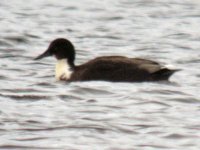Just to explain a bit, nearly all domestic ducks are descended from Mallards. The exceptions are Muscovy Ducks. Mallards (domestic or not) may hybridise with Muscovy Ducks (domestic usually) but their hybrid offspring are not fertile. Thus a domestic duck that isn't a Muscovy Duck and isn't a first-generation Muscovy Duck x Mallard hybrid is a Mallard. Selective breeding of domestic Mallards has produced a large variety of different "breeds" of Mallard which vary enormously in plumage, bare parts, size and structure but they are all 100% Mallard and not hybrids between Mallards and any other species. A cross between two domestic breeds of Mallard is better described as a crossbreed than a hybrid. People who keep ducks seem to operate on a different taxonomy to birders, treating different "pure" breeds (e.g. Saxony, Aylesbury, etc., that are all 100% Mallard) in just the same way as different species, and as a result they don't differentiate between a crossbreed and a hybrid between two species, so the terms get used interchangeably (I'm sure there are exceptions, but that's my experience). Those of us who recognise a difference between two domestic breeds of the same species and two natural species find it preferable to reserve the term 'hybrid' for a cross that has two species in its ancestry, which is not the case for domestic ducks (except the occasional infertile Mallard x Muscovy).
For breeders, a pure breed is only identified by looking at its offspring. Mutations are such that a domestic duck that is a cross-breed may appear identical to a pure-breed, the difference is that if you mate two pure-breeds the offspring will all look like that breed (except in very rare instances) whereas if you mate two cross-breeds or a cross-breed with a pure-breed then the chances are you'll get variation in the appearance of their young, even if both parents looked like the pure-breed. For this reason unless the Mallards have been kept and bred in a controlled environment they are extremely unlikely to be pure-breeds - they are almost certainly cross-breeds even if they resemble one or other breed. As some domestic breeds are very similar to wild Mallards you can't really tell if one parent is a wild Mallard or not. Domestic variants are not as stable as different species and the appearance of their offspring is not as predictable - you cannot look at a domestic duck, see clear characteristics that resemble breed X and breed Y and assume it's got breed X and breed Y in its ancestry. That's why I think it's safer to describe any Mallard that shows signs of a domestic heritage as simply a domestic variant of Mallard. Leave it to the people who keep and breed them in controlled environments to call them Aylesbury or Blue Swedish or whatever.
Of course these domestic variants of Mallards do hybridise sometimes with other species, but such hybrids are relatively rare. Don't underestimate the amount of variation that exists within the domestic variants of Mallard - if some throw up features that remind you of Gadwall or Pintail etc. then in all probability it has absolutely nothing to do with Gadwall or Pintail, it's just part of their (un)natural variation.







